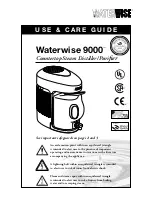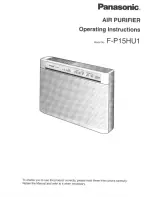
The heating value of the gas may differ with locality. The value
should be checked with the local gas utility.
NOTE: There may be a local gas utility requirement specifying
a minimum diameter for gas piping. All units require a
1/2 inch pipe connection at the entrance fitting.
GAS CONNECTION
The gas supply line can be routed through the knockouts
located on the front of the unit or through the opening provided
in the unit’s base. Refer to Figure 7 to locate these access
openings. Typical supply piping arrangements are shown in
Figures 3 and 4. All shaded items are field-supplied.
Two grommets are shipped in the blower compartment (in parts
bag taped to the blower housing) of every unit with gas heat
and should be used in the knockouts when the gas piping
penetrates the front of the unit.
After the gas supply piping has been installed, the bottom
opening should be sealed to prevent water from leaking into
the building.
Gas piping recommendations:
1. A drip leg and a ground joint union must be installed in the
gas piping.
2. When required by local codes, a manual shut-off valve may
have to be installed outside of the unit.
3. Use wrought iron or steel pipe for all gas lines. Pipe
compound should be applied sparingly to male threads
only.
WARNING: Natural gas may contain some propane. Propane,
being an excellent solvent, will quickly dissolve
white lead or most standard commercial com-
pounds. Therefore, a special pipe compound must
be applied when wrought iron or steel pipe is used.
Shellac base compounds such as Gaskolac or
Stalastic, and compounds such as Rectorseal #5,
Cyde’s or John Crane may be used.
4. All piping should be cleaned of dirt and scale by hammering
on the outside of the pipe and blowing out the loose dirt and
scale. Before initial start-up, be sure that all of the gas lines
external to the unit have been purged of air.
5. The gas supply should be a separate line and installed in
accordance with all safety codes as prescribed under
“Limitations”. After the gas connections have been
completed, open the main shut-off valve admitting normal
gas pressure to the mains. Check all joints for leaks with
soap solution or other material suitable for the purpose.
NEVER USE A FLAME.
6. The furnace and its individual manual shut-off valve must
be disconnected from the gas supply piping system during
any pressure testing of that system at test pressures in
excess of 1/2 psig (3.48kPa).
The furnace must be isolated from the gas supply piping
system by closing its individual manual shut-off valve during
any pressure testing of the gas supply piping system at test
pressures equal to or less than 1/2 psig (3.48kPa).
7. A 1/8 inch NPT plugged tapping, accessible for test gage
connection, must be installed immediately upstream of the
gas supply connection to the furnace.
L.P./PROPANE UNITS, TANKS AND PIPING
All gas heat units are shipped from the factory equipped for natural
gas use only. The unit may be converted in the field for use with
L.P./propane gas with accessory kit model number 1NP0440.
All L.P./propane gas equipment must conform to the safety
standards of the National Fire Protection Association.
For satisfactory operation, L.P./propane gas pressure must be
10.5 inch W.C at the unit under full load. Maintaining proper gas
pressure depends on three main factors:
1. The vaporization rate which depends on (a) the
temperature of the liquid and (b) the “wetted surface” area
of the container or containers.
2. The proper pressure regulation. (Two-stage regulation is
recommended from the standpoint of both cost and
efficiency.)
3. The pressure drop in the lines between regulators and
between the second stage regualtor and the appliance.
Pipe size required will depend on the length of the pipe run
and the total load of all appliances.
Complete information regarding tank sizing for vaporization,
recommended regulator settings, and pipe sizing is available from
most regulator manufacturers and L.P./propane gas suppliers.
L.P./propane gas is an excellent solvent and special pipe
compound must be used when assembling piping for this gas
as it will quickly dissolve white lead or most standard
commercial compounds. Shellac base compunds such as
Rectorseal #5 are satisfactory for this type of gas.
Check all connections for leaks when piping is completed,
using a soap solution. NEVER USE A FLAME.
LOW NOx APPLICATION
For natural gas heat installations in locations which require low
Nitros Oxide emmissions, accessory model 1LN0404 must be
installed.
FIG. 3 - EXTERNAL SUPPLY CONNECTION
EXTERNAL SHUT-OFF
FIG. 4 - BOTTOM SUPPLY CONNECTION
EXTERNAL SHUT-OFF
530.18-N8W
6
Unitary Products Group






































